Our cities and suburbs are a microcosm of human experience, a place of energy, interaction, geometric landscapes, and diverse communities. It is no surprise that these places have been the muse for many celebrated artists. However, the faces of children playing double Dutch, hopscotch, roller skating, and blowing bubbles in urban settings, and, more importantly, the faces of Black youth, have largely gone unexplored as subjects on the depictive surface of pottery.
Many historic and contemporary photographers, like the Chicago-based artist Vivian Maier and the New York artist Bruce Davidson, have masterfully captured the spontaneity of street scenes. Photography is no stranger to this landscape, and the medium, in truth, best parallels the immediacy needed to capture fleeting moments. Ceramics, by comparison, are commonly celebrated for the atmospheric qualities of the glazing and firing processes as well as their form and function. However, the ceramic slipped-trailed surfaces that Michelle Ettrick creates evoke the energy and movement of a candid photo, a frozen moment-narrative that we hold in our mind's eye that could shoot to life beyond its vitrified existence.
An Afro-Latina from Panama who moved to the United States in 1982, Ettrick has been capturing and creating scenes from her experience on the surface of pottery since well before the diversity, equity, and inclusion movements of the 2020s.
EARLY YEARS
While Ettrick wanted to be an artist from an early age, the mindset of her parents' generation, as she describes, was that being an artist is "not gonna be something to give you money. You got to get a job." Beyond the stigma of the starving artist, Ettrick’s exposure to art as a child held other barriers. "My mom was a housekeeper at a hotel, and we were on welfare." As Ettrick states, "Even when you went to high school, you've got to have money to buy art supplies."
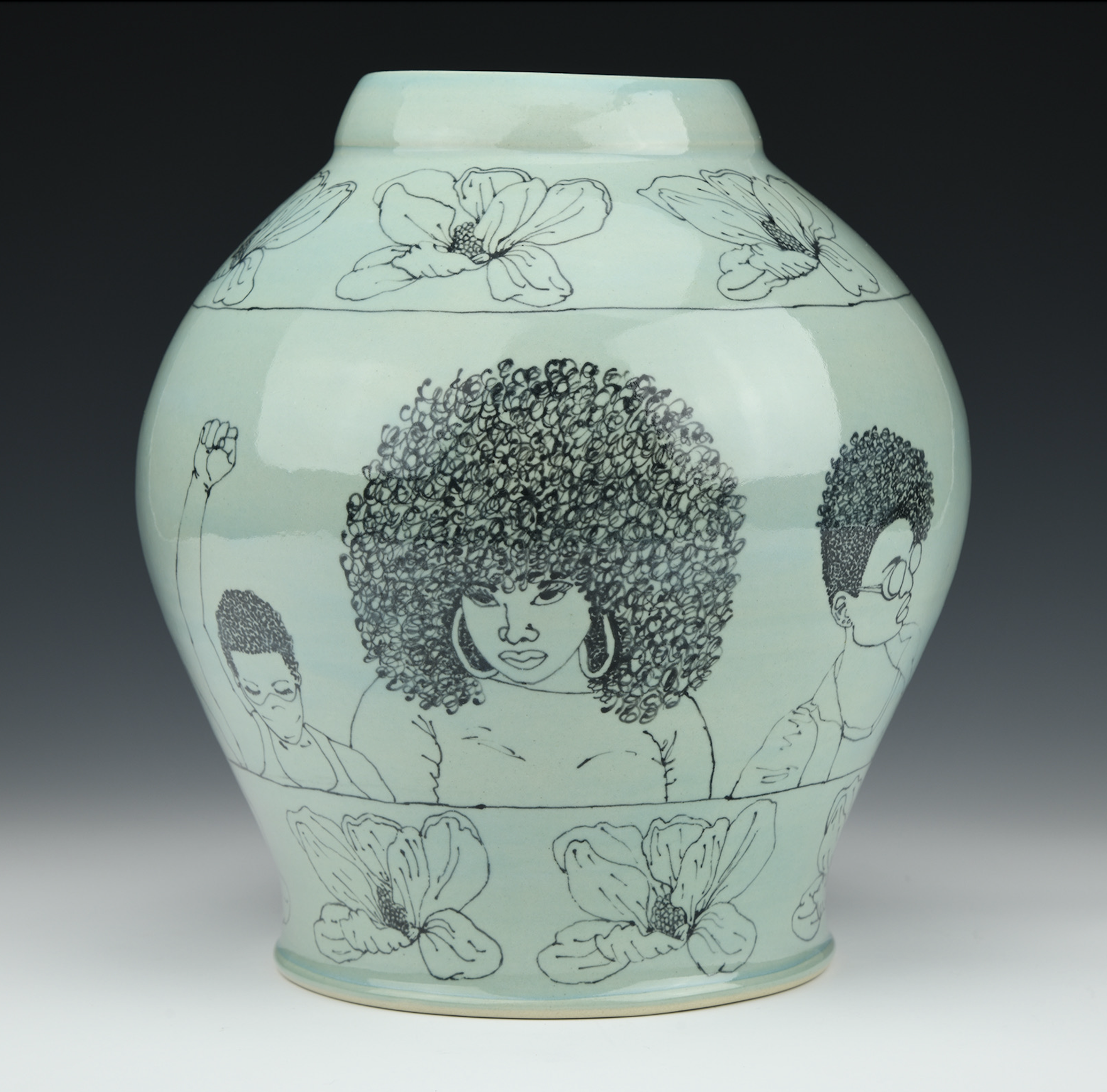 Even in the face of financial hardship, Ettrick's creative pursuits were not dampened. Ettrick worked with materials she could readily find, using scrap fabric to create Black cloth dolls and making patterns from forms that she could naturally deconstruct with her mind's eye. Ettrick's three-dimensional sensibility came instinctively to her. Though she was creatively gifted, Ettrick's move to the U.S. was difficult for a non-English speaking girl who didn't quite fit the uniform categories of Black or Latina. On Ettrick's website, she states, "My own identity was regularly challenged by others who judged me by the texture of my hair or the fact that I spoke Spanish fluently and struggled to communicate in English. When judged by adults and my peers, my hair was 'too good' to be considered black, and the color of my skin was too dark to be speaking Spanish."
Even in the face of financial hardship, Ettrick's creative pursuits were not dampened. Ettrick worked with materials she could readily find, using scrap fabric to create Black cloth dolls and making patterns from forms that she could naturally deconstruct with her mind's eye. Ettrick's three-dimensional sensibility came instinctively to her. Though she was creatively gifted, Ettrick's move to the U.S. was difficult for a non-English speaking girl who didn't quite fit the uniform categories of Black or Latina. On Ettrick's website, she states, "My own identity was regularly challenged by others who judged me by the texture of my hair or the fact that I spoke Spanish fluently and struggled to communicate in English. When judged by adults and my peers, my hair was 'too good' to be considered black, and the color of my skin was too dark to be speaking Spanish."
After a series of moves back and forth from Panama, Florida, and New York, and upon her graduation from high school, Ettrick found the opportunity to briefly attend the Bronx Community College when she was nineteen. She sought an associate's degree in science but then chose to direct her attention to raising her firstborn child. As a single working mom, Ettrick experienced multiple barriers to ensuring stability for her family. While Ettrick is the first to see the positive in all her experiences, it goes without saying that many of the social structures and systems that she encountered – lack of available and affordable housing, restrictions from education to obtain sufficient wages, gaps in services, and structural barriers – led to a complex experience with homelessness that began in 2010.
Listening to Ettrick retell her story of being a single working mom who eventually became homeless, there is neither a trace of resentment nor a sense that she was dealt an unfair hand. Nostalgia radiates from her stories as she remembers how she taught herself to drive and was able to get a car by working positions in construction, cleaning, and being a cable connector. Resiliency and grace emanate from her reflections on caring for her two children alone and eventual time in a shelter. It was in Florida and with the assistance of Section Eight that the vacancy of a one-bedroom apartment crossed her path and began her journey out of homelessness. The route out of homelessness was also the path that would bring clay to Ettrick's hands.
CLAY
As Ettrick was on the Section Eight waiting list and living at the Salvation Army shelter with her two children, she also applied to attend the local college. With no computer or printer at the shelter, Ettrick went to the college to begin and ultimately print her college application. As she was seeking help with the application, Ettrick reflects, "When I was putting together my application, apparently, you know, if you say, XYZ whatever street, they knew that specific address was the shelter. It was a Salvation Army shelter. They knew that that was the shelter. To me, it feels like you shouldn't even be asking me, and I feel like you're putting me on the spot. Right? So then [the administrative assistant] was like, 'I'll be right back. I'm going to get your paper from the printer.' She went over there, asked me to have a seat, and then she went to the dean. This didn't seem normal. So, then they're talking, and the dean then comes and asks for me, and we begin talking. He asked me all these questions, and I explained to him a little bit about what had happened in my life. Sometimes it's good to talk because you could meet people that either put you on the right path or they could know something that could help you that you didn't know about. We had a whole conversation, and then he said I'm going to waive your tuition. He waived my tuition for the first year! Oh, my goodness. You know how big that is to me?"
While Ettrick's application experience made for an uncomfortable but essential exchange, this encounter would act as one of the pivotal socioeconomic bridges in her life. While living at the shelter, Ettrick attended her first year of college at the College of Central Florida in Ocala. After a year on the Section Eight waiting list, the doors opened for the one-bedroom apartment. With the second socioeconomic bridge constructed, she settled her two children in their new bedroom while she slept in the living room.
With services and stability in place, Ettrick intended to study business but found herself pulled towards the arts. She pivoted to an Associate of Arts degree. Ettrick then found her visual voice in the ceramics studio under the mentorship of Charlie Cummings. In Ettrick's artist statement, she conveys the significance of choosing clay as her medium of choice. "Clay is a very personal material to me. When I put my hands in the clay, and my fingers get lost in the mixture, for the moment, we become one. I stretch, pull, pinch and form shapes where I leave evidence of my having been there."
In the four years that Ettrick studied at CCF, Cummings would be the catalyst for several metaphorical bridges that empowered Ettrick to pursue a career in ceramics. Cummings helped Ettrick receive a work-study position as a ceramic technician, which allowed her to provide necessities and save enough money to buy a TV for her family. Cummings cultivated the mindset of a sustainable and fulfilling career in ceramics versus the grind of a nine-to-five job. Ettrick relates another one of these defining and bridging moments when Cummings offers an opportunity for his class to earn extra credit by attending an art reception in Gainesville, Florida.
Ettrick reflects, "I was like, 'Oh, I don't need no extra credit.' I say, 'No, I don't need to go because I don't need extra credit.' Because I knew I was getting solid grades." Lightheartedly and jokingly, Ettrick continues, "Charlie goes 'No. For you, if you don't go, I'm taking points away.'" In a sincere and empathetic manner, Ettrick affirms, "He wanted to expose me to that, to the exhibition, to the people. So, Yeah, why not go?" Ettrick shifts into her warm storytelling tone, "So, here's the best part. [The class] all drive over in cars together, we all study together, and we all get in the same groups at the exhibition. Because we were like, 'We don't know anybody.' We were all talking, and then Charlie came up, and he said, 'Michelle, come with me.' The student group was a bit confused, and he was like, 'Well, I just need her to come meet some people right now.' And then I followed him, and he introduced me to Linda Arbuckle."
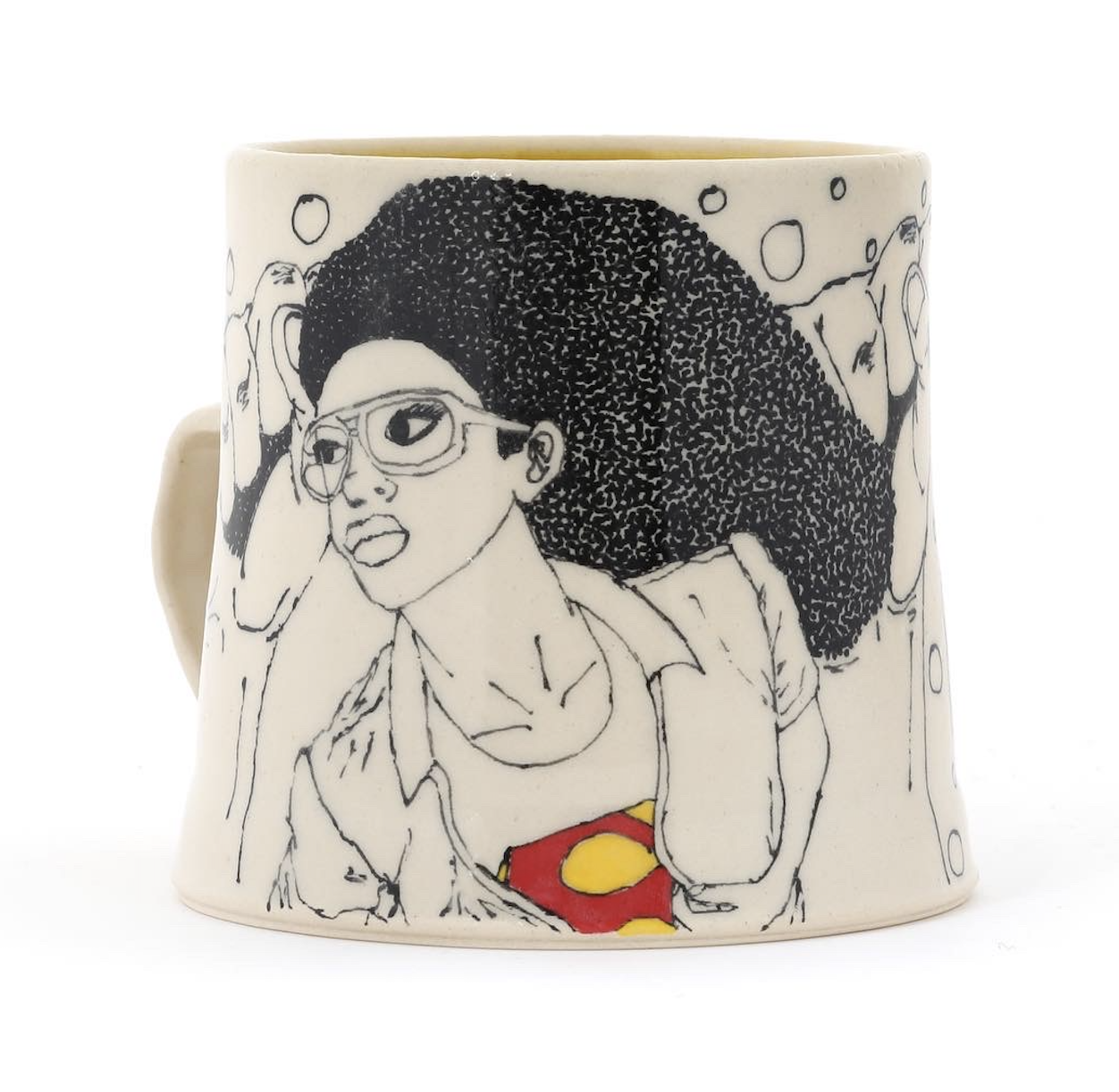 Ettrick was both surprised and taken aback because Arbuckle seemed to know her work, though Ettrick couldn't connect how or why Arbuckle would be aware of her ceramics. As Ettrick recalls, Arbuckle says, "Oh come on. Charlie's just been sending me [images of] everything you make." Cummings gave Ettrick a knowing look, then politely removed himself from the conversation to allow Ettrick and Arbuckle to continue their discussion. Ettrick continues, "[Arbuckle] said, 'When are you going to come to the University of Florida?' I was like, 'I don't know. I don't know that I am.' I was forty-four, you know. I don't know that I can do this. My kids! They are not young, but my daughter was 18."
Ettrick was both surprised and taken aback because Arbuckle seemed to know her work, though Ettrick couldn't connect how or why Arbuckle would be aware of her ceramics. As Ettrick recalls, Arbuckle says, "Oh come on. Charlie's just been sending me [images of] everything you make." Cummings gave Ettrick a knowing look, then politely removed himself from the conversation to allow Ettrick and Arbuckle to continue their discussion. Ettrick continues, "[Arbuckle] said, 'When are you going to come to the University of Florida?' I was like, 'I don't know. I don't know that I am.' I was forty-four, you know. I don't know that I can do this. My kids! They are not young, but my daughter was 18."
Uncertain of her path and feeling the all too familiar pulles of parental duty versus personal passion, Ettrick left applying for her BFA until the final hour. Ettrick reminisces about the tipping point that got her to apply, "Charlie dropped off my recommendation letter by hand. He said, 'I'm going to drop off this letter for you. You go apply if you want to apply, but the letter is there for you.'"
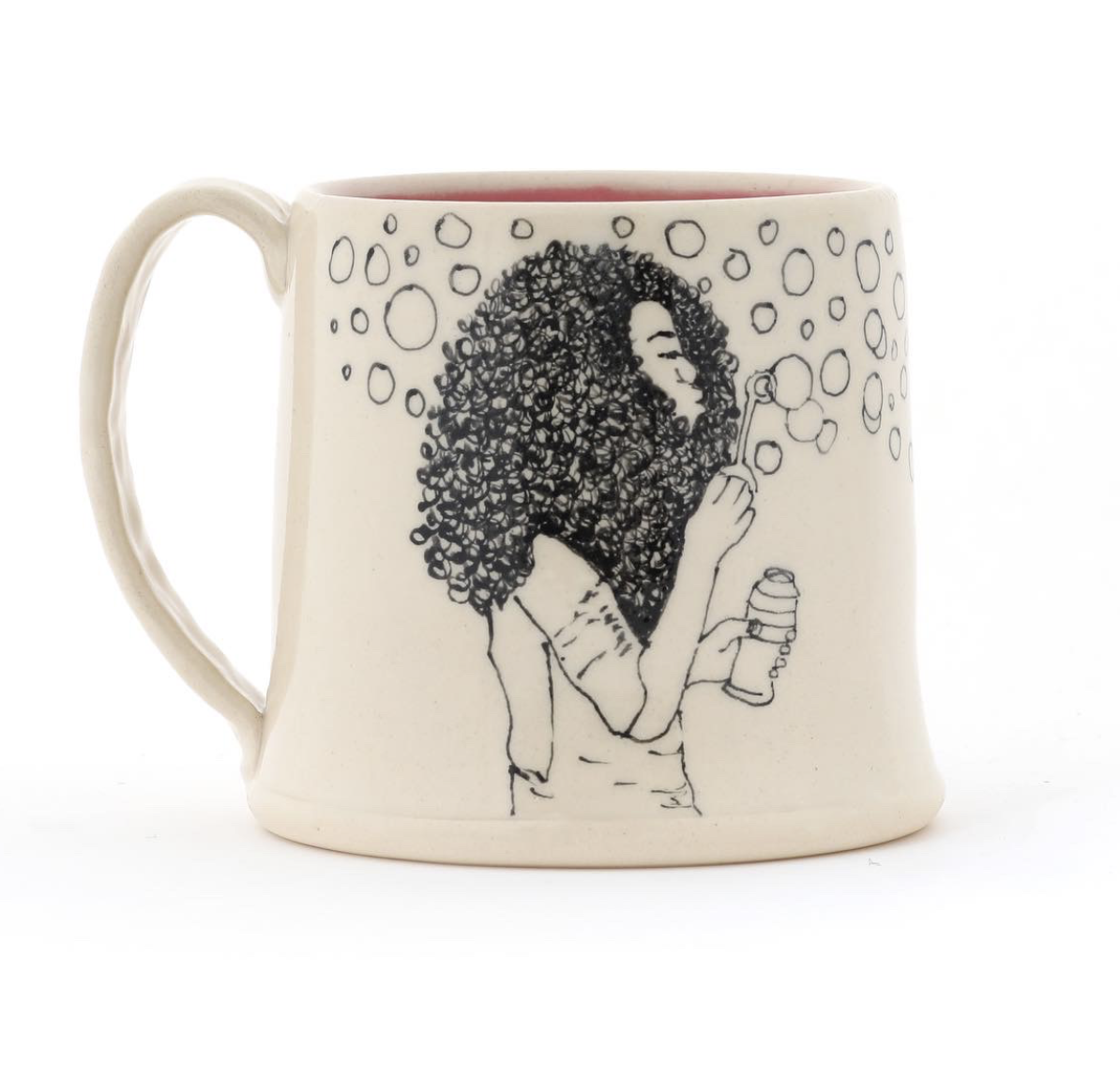 While Ettrick went on to receive her Bachelor of Fine Arts from the University of Florida in 2017 and her Master of Fine Arts from Pennsylvania State University in 2019, her story is not found in the degree but in the bridges along her path. Ettrick is gregarious and expressive as she recounts her accomplishments in the bridged gaps ranging from poverty to stability, and from grinding the nine-to-five jobs to accessing education, which would provide her current career as a ceramic professor. While she is prolific in exchanging stories, she is intentional when she pauses to remember the people who became invaluable socioeconomic bridges along her path. Cummings would continue to be a significant bridge builder and mentor throughout Ettrick's journey.
While Ettrick went on to receive her Bachelor of Fine Arts from the University of Florida in 2017 and her Master of Fine Arts from Pennsylvania State University in 2019, her story is not found in the degree but in the bridges along her path. Ettrick is gregarious and expressive as she recounts her accomplishments in the bridged gaps ranging from poverty to stability, and from grinding the nine-to-five jobs to accessing education, which would provide her current career as a ceramic professor. While she is prolific in exchanging stories, she is intentional when she pauses to remember the people who became invaluable socioeconomic bridges along her path. Cummings would continue to be a significant bridge builder and mentor throughout Ettrick's journey.
In June of 2020, Ettrick received the support of another bridge. On the popular social media feed of Adam Field, Ettrick's work was featured in tandem with the broader social media movement relating to the #BlackOutTuesday – June 2nd, 2020, a proposed day of reflection after the death of George Floyd. On June 11th, 2020, Field wrote on his social media platforms, "In an effort to support Black clay community members in a more meaningful and long-lasting way. I am featuring artists here on my feed with a request of support from you (yes you!). It has been heartening to see such an outpouring of support in recent days as the clay community has turned a spotlight on Black artists, their work, social media feeds, and online sales, but those only go so far." Field continued by listing select Black artists' PayPal, Venmo, and CashApp info on his post.
 Ettrick was one of the artists that Field listed, and before long, donation alerts began pinging on Ettrick's accounts. The social media gesture assisted Ettrick in buying her own kiln and glazing materials. Ettrick expresses the sincerest gratitude, "[Because of the kiln], that's when I started to make bigger work and more work. I think people sometimes take it for granted and they forget to have that gratitude. Gratitude just to be human and say thank you. I wanted to put it out there so that people know that they did something nice for me. It's something that I will pay forward."
Ettrick was one of the artists that Field listed, and before long, donation alerts began pinging on Ettrick's accounts. The social media gesture assisted Ettrick in buying her own kiln and glazing materials. Ettrick expresses the sincerest gratitude, "[Because of the kiln], that's when I started to make bigger work and more work. I think people sometimes take it for granted and they forget to have that gratitude. Gratitude just to be human and say thank you. I wanted to put it out there so that people know that they did something nice for me. It's something that I will pay forward."
Although efforts to support and underscore Black ceramic artists gained momentum in the summer of 2020, after the murder of George Floyd on May 25th, 2020, Ettrick had been documenting her visual surroundings well before this tragedy. Creating three-dimensional forms of the clenched fist – a fist of solidarity, pride, and perseverance – as early as 2015 perfectly aligned Ettrick to be a visual spearhead for contemporary trends in social media political art. While positioned to make political statements, Ettrick states, "I've never been a super political person. Yeah, even though people look at my work and say that they see these political things, I say, 'Nah, it's just me.' It happens to be a subject that is hot or whatever right now, you know? But I just like quietly doing work because I am all about making work that people are going to enjoy and smile at. "
While, on the one hand, Ettrick is right that Black artists are trending, on the other hand, her work is not a novelty statement or tokenistic gesture that waxes and wanes with the trend. Her work and gallery representation, predating 2020 trends, are part of our society's evolving aesthetic.
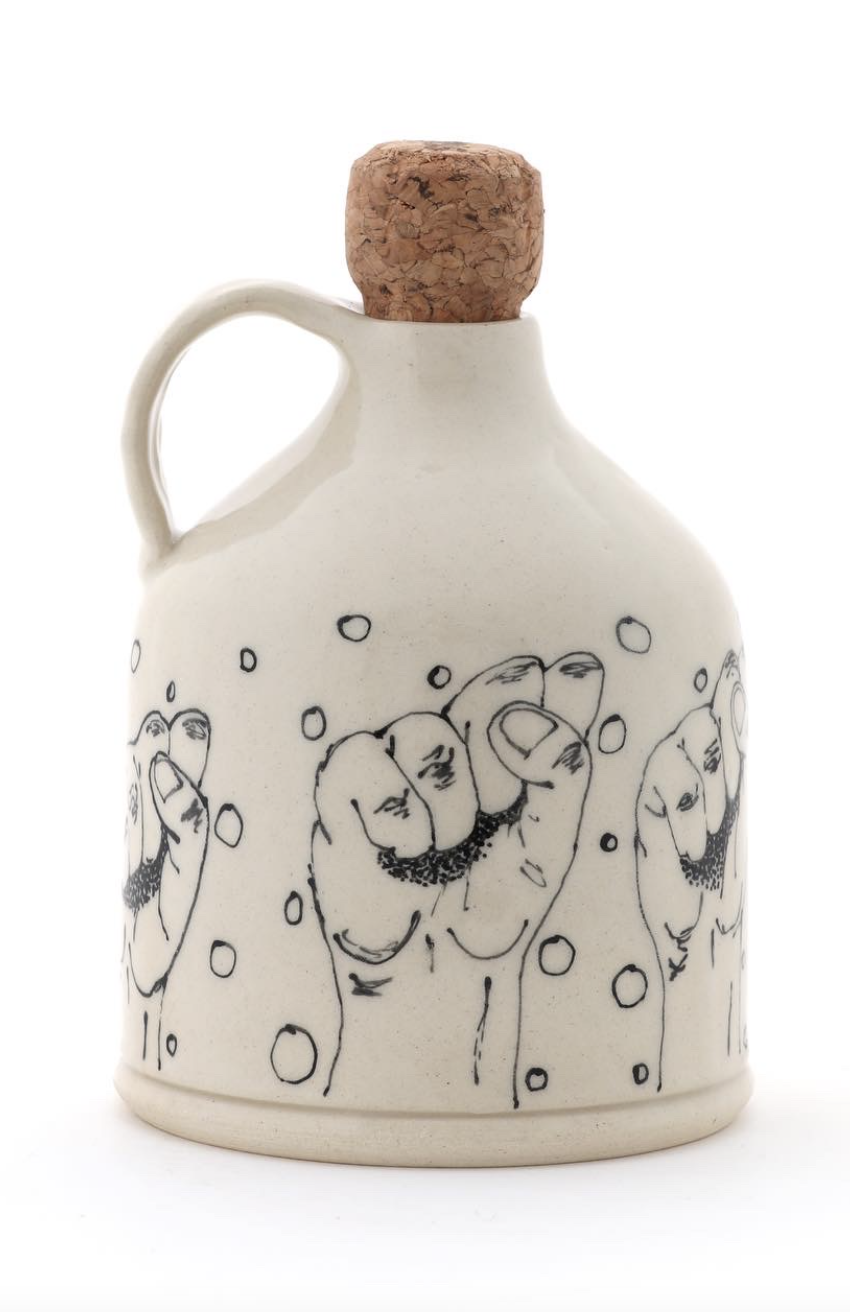 The symbolic clenched fist has been a part of the world's visual culture since the 1848 French revolution. It has been a keystone symbol of solidarity for the U.S. civil rights movement of the early 60s, which laid the groundwork for the clenched fist symbol to be used by the Black Power movement and the current Black Lives Matter movement. While trending in social media culture, the clenched fist has consistently been a part of Ettrick's visual influence, and she has been using this symbol for years. "My artwork is a record of my experiences as an Afro-Latina American," she continues as she describes her ceramic surfaces. "I embrace my naturally curly hair, heritage, womanhood, and at times current worldly struggles." It is no trend that Ettrick uses the clenched fist, given the context that she came to the U.S. in the 1980s and certainly experienced ongoing racism and injustice in the United States.
The symbolic clenched fist has been a part of the world's visual culture since the 1848 French revolution. It has been a keystone symbol of solidarity for the U.S. civil rights movement of the early 60s, which laid the groundwork for the clenched fist symbol to be used by the Black Power movement and the current Black Lives Matter movement. While trending in social media culture, the clenched fist has consistently been a part of Ettrick's visual influence, and she has been using this symbol for years. "My artwork is a record of my experiences as an Afro-Latina American," she continues as she describes her ceramic surfaces. "I embrace my naturally curly hair, heritage, womanhood, and at times current worldly struggles." It is no trend that Ettrick uses the clenched fist, given the context that she came to the U.S. in the 1980s and certainly experienced ongoing racism and injustice in the United States.
Ettrick often takes a gentle approach when describing the meaning of the people and places she captures on the surface of her ceramics, stating, "I just want people to smile when they see my work," or "These are just memories on the lawn, and the playing, and all the things that I'm just connecting to." While Ettrick is sincere and authentic in her intentions, from an art theoretical perspective, she is positioned to be one of the contemporary Black ceramic artists who change the field from within. Ettrick's work looks beyond and plays within the power of the gaze. In her pieces with sceneries of children playing hopscotch or double Dutch, the youthful characters are so deeply entwined in their games that they seem unaware of the audience. The energetic characters' gazes are focused on their play, the action, and the joy. The audience is placed in the role of an onlooker or a passerby, witnessing the playmaking but discreetly aside. Ettrick's surface work is composed with underglaze and a slip-trailer, but the action scenes harken back to the street photography genre.
Ettrick also captures images of singular women looking directly out of the picture plane and at the audience. The images reflect hints of the selfie or snapshots of women with confident gestures. Ettrick's female representations play in the arena of individual identity and self-representation. While hinting at portraiture, the modernity of Ettrick's work – the use of readily available technology, smartphones, and social media as a tool to look at while translating to the surface of clay – functions as an effective medium to challenge sociocultural values, such as self-representation for Black women. The female characters seem aware of the audience, and the posturing Ettrick chooses empowers the female characters' autonomy and ability to challenge the audience's gaze. While Ettrick was never so openly bold in our interview to make the following claim, it has been prolifically documented that people of color and women break down gender and racial oppression by distributing[1] self-representation images. Ettrick's female imagery is both the subject of looking and the object doing the looking; the female forms are the objects of underrepresentation as well as the tools being used to challenge that oppression.
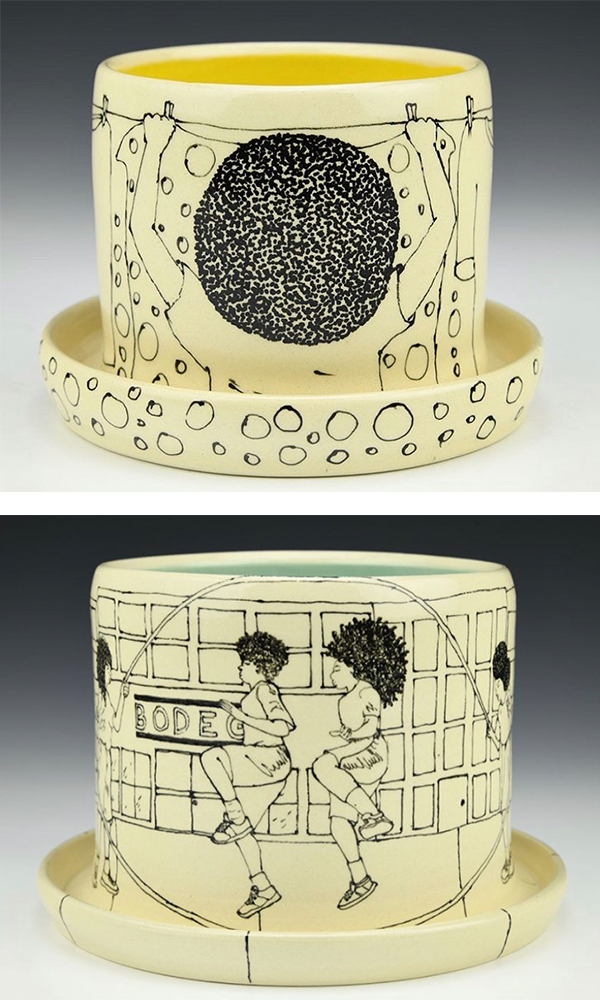
With unscripted scenes and a snapshot aesthetic, Ettrick has a natural command of imbuing her ceramic surfaces with life. Avoiding caricature or overtly stylized methods, Ettrick prompts the viewer to linger and watch, to observe in ways that a posed still life and decorative patterns don't ask of an audience. By placing her imagery on the surface of ceramic vessels, Ettrick creates a another level of intimacy. The use of functional ceramics as a delivery mode – something so normal and inherent within the home – normalizes Ettrick's memories and experiences of being an Afro-Latina, because playing hopscotch, blowing bubbles, hanging laundry out on the line to dry, holding a teacup, and standing in solidarity is the Black experience, but it is also an authentic and universal display of the human experience.
At this point, I wind down Ettrick's article with one last story of bridge building. Ettrick and I sat down for this interview on March 17th, 2022, after she presented at the National Council on Education for the Ceramic Arts. We spoke and exchanged stories for over three hours, and in truth, it didn't feel long enough to hear all that Ettrick had to share. The following day, as I walked back through the Sacramento streets to the conference, Ettrick was outside, sitting and exchanging stories with a homeless woman, Deborah. Much like the gaze of Ettrick's playful scenes, I stopped just far enough to go discreetly unnoticed. Later that evening, I pulled up Ettrick's social media feed to confirm her social media stories. There was a new story and post: Ettrick was raising money for Deborah, the same woman I had seen her speaking with earlier that day. Ettrick is humble when she speaks of herself, her art, and her story, but Ettrick is bold and courageous when acting as the bridge for others. The $300 Ettrick raised provided, at the very least, a night off the streets for Deborah.
The money received and paid forward throughout Ettrick's life story is a socioeconomic bridge, and I believe Ettrick's art is an aesthetically and socially significant bridge for the future of ceramic art. Indeed, it feels like the Black, Indigenous, persons of color (BIPOC) allies within the ceramics community are pressing towards a more integrated art model. Still, the barometer of trending art versus a stabilized aesthetic will be seen in placing the power of the gaze, the power of profit[2], and the power of bridge building in the hands of BIPOC ceramic artists. Ettrick's resilience and grace, along with her art, will undoubtedly be one of the many bridges that better the ceramic consciousness.
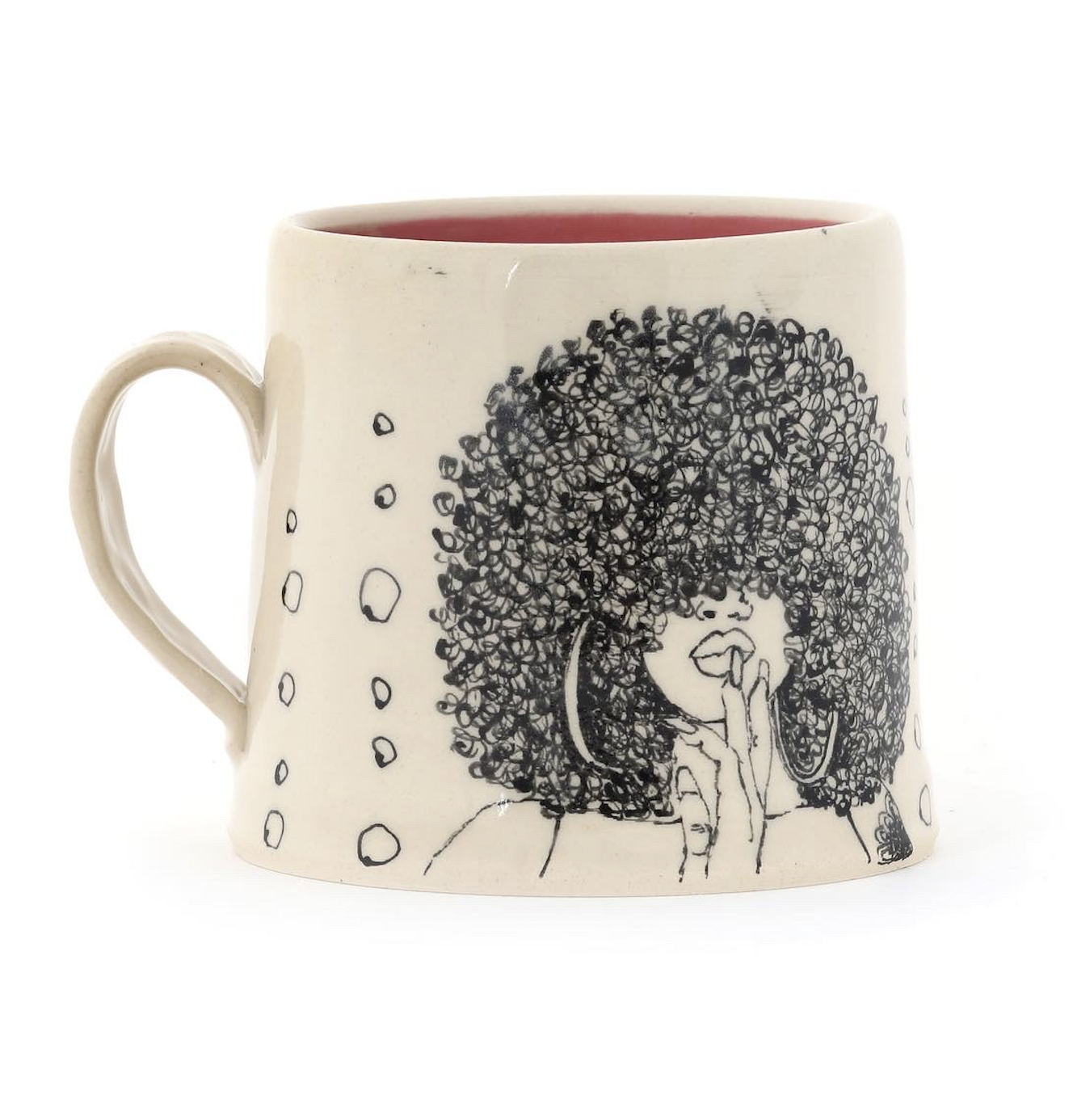 NOTES
NOTES
[1] For more reading on gender, race, and self-representation see:
"Women and Art: Idenity and Action," National Gallery of Art, https://www.nga.gov/learn/teachers/lessons-activities/uncovering-america....
"30 Black Women Trailblazing Visual Representation and Racial Justice," Frieze Week Magazine, April 27, 2021,https://www.frieze.com/article/30-black-women-trailblazing-visual-repres...
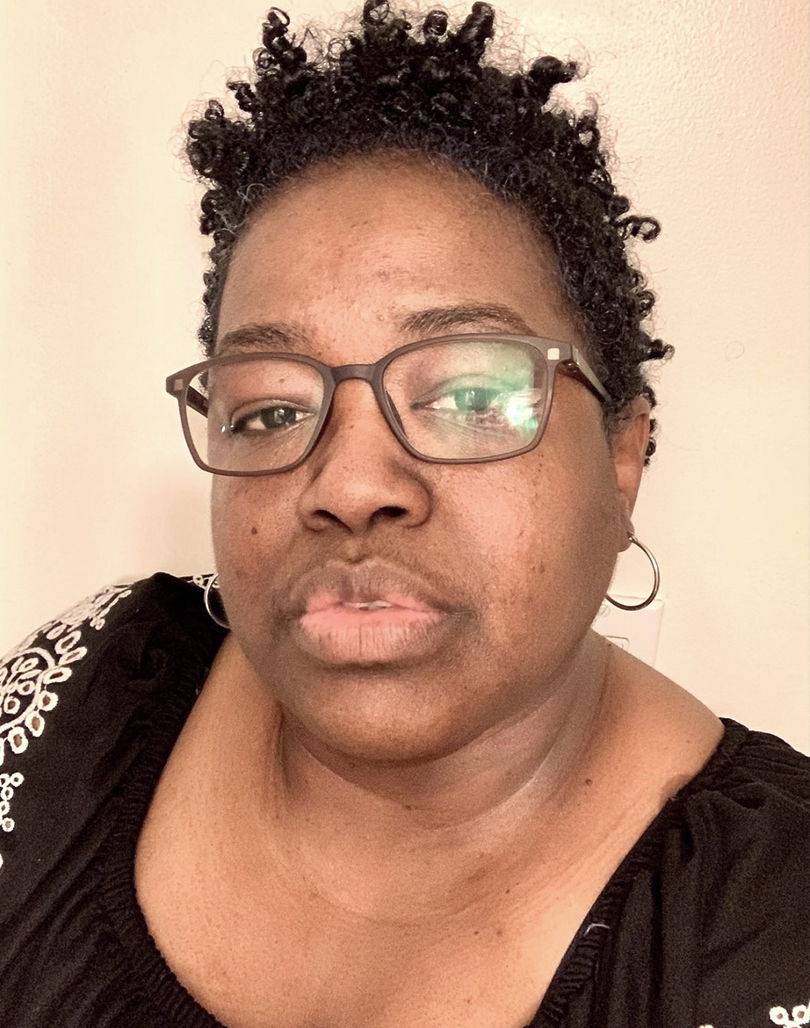
[2] Debra Hand, “Black Artists, Collectors, and the new Black Art Boon–What’s to Come of This?” Black Art in America, January 12, 2022, https://www.blackartinamerica.com
For access to buy directly from Michell Ettrick follow her shop at: https://www.michelleettrick.com/purchase
Ways you can help those suffering from homelessness
Stigma and discrimination against homeless populations is incredibly dangerous. To learn about how you can help homeless women, men, and children check out the following articles.
1. To find shelters in your area specializing in homeless women who are pregnant or have children: https://www.artistshelpingchildren.org/shelters.html
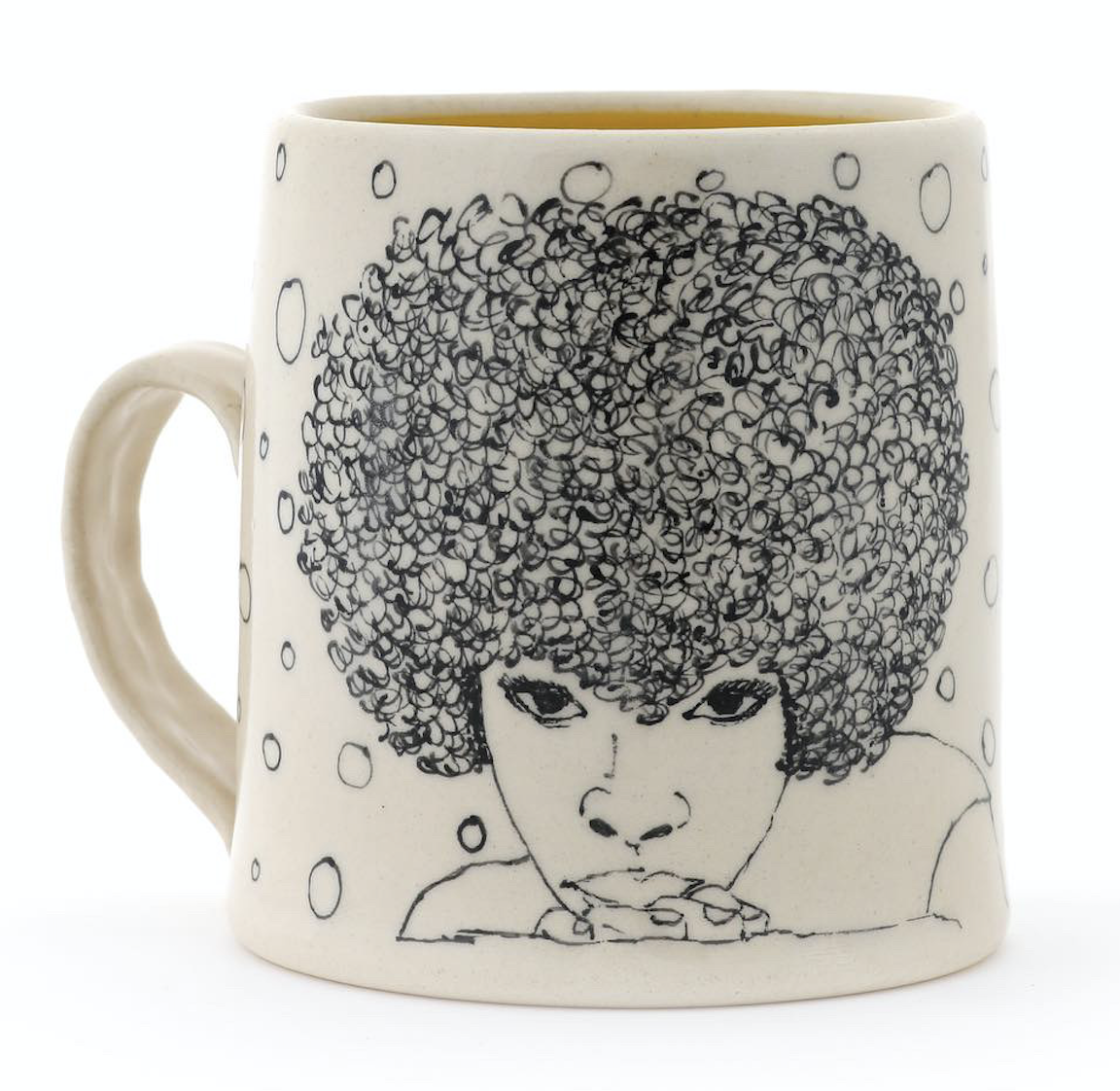
2. For shelters in your area specializing in victims of violence: https://www.womenslaw.org/find-help/advocates-and-shelters
3. “From emergency shelters to long-term housing, The Salvation Army provides a wide array of services to those facing life on the streets.” You can donate locally or nationally at: https://www.salvationarmyusa.org/usn/provide-shelter/
 Share
Share